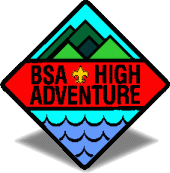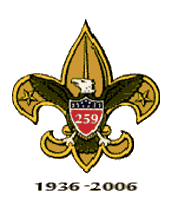Advancement for Youth Members with Special Needs
Resource Links
The following are the guidelines for membership and advancement in Scouting for persons
having disabilities or other special needs.
The American with Disabilities Act of 1990 (ADA) provides the following definition of
an individual with a disability:
"An individual is considered to have a 'disability' if s/he has a physical or
mental impairment that substantially limits one or more major life activities (e.g., . . .
seeing hearing, speaking, walking, breathing, performing manual tasks, learning, caring
for oneself, and working), has a record of such impairment, or is regarded as having such
an impairment.
"An individual with epilepsy, paralysis, HIV infection, AIDS, a substantial
hearing or visual impairment, mental retardation, or a specific learning disability, is
covered, but an individual with a minor, nonchronic condition of short duration, such as a
sprain, broken limb, or the flu would not be covered by the ADA.
"The ADA definition protects individuals with a record of a disability and would
cover, for example, a person who has recovered from cancer or mental illness.
"And the ADA protects individuals who are regarded as having a substantially
limiting impairment, even though they may not have such an impairment. For example . . . a
qualified individual with a severe facial disfigurement is protected from being denied
employment because an employer feared the 'negative reactions' of customers or
coworkers."
The Department of Education identifies a severely handicapped child as one who, because
of the intensity of his physical, mental, or emotional problems, or a combination of such
problems, needs education, social, psychological, and medical services beyond those that
have been offered by traditional regular and special educational programs, in order to
maximize his full potential for useful and meaningful participation in society and for
self-fulfillment. Such children include those classified as seriously emotionally
disturbed or profoundly and severely mentally retarded, and those with two or more serious
handicapping conditions, such as the mentally retarded blind, and the cerebral-palsied
deaf.
Membership
The chartered organizations using Scouting determine, with approval from appropriate
medical authorities, whether a youth member is qualified to register (based on the above
definitions) beyond the normal registration age. The Cubmaster's signature on the Cub
Scout application, the Scoutmaster's signature on the Boy Scout application, the Varsity
Scout Coach's signature on the Varsity Scout application, the Advisor's or Skipper's
signature on the Venturing application, or on the unit's charter renewal application
certify the approval of the chartered organization for the person to register. The local
council must approve these registrations on an individual basis.
The medical condition of all candidates for membership beyond the normal registration
age must be certified by a physician licensed to practice medicine, or an evaluation
statement must be certified by an educational administrator. Use the Personal Health and
Medical Record Form. Any corrective
measures, restrictions, limitations, or abnormalities must be noted. In the case of
mentally retarded or emotionally disturbed candidates for membership, their condition must
be certified by a licensed psychologist or psychiatrist. Current health, medical, or
certification records of all youth members beyond the normal registration age who have
disabilities are to be retained in the unit file at the council service center.
Boy Scout Advancement
All current requirements for an advancement award (ranks, merit badges, or Eagle Palms)
must be actually met by the candidate. There are no substitutions or alternatives
permitted except those which are specifically stated in the requirements as set forth in
the current official literature of the Boy Scouts of America. Requests can be made for
alternate rank requirements for Tenderfoot, Second Class, and First Class using the
information outlined in this chapter. No council, district, unit, or individual has the
authority to add to, or to subtract from, any advancement requirements. The Scout is
expected to meet the requirements as stated -- no more and no less. Furthermore, he is to
do exactly what is stated. If it says, "show or demonstrate," that is what he
must do. Just telling about it isn't enough. The same thing holds true for such words as
"make," "list," "in the field," and "collect, identify,
and label."
Alternate Requirements for Tenderfoot, Second Class, and First Class Ranks.
A Scout who is unable to complete any or all of the requirements for Tenderfoot, Second
Class, or First Class rank because he is physically or mentally disabled may complete
alternative requirements if the following criteria are met:
- The physical or mental disability must be of a permanent rather than a temporary nature.
- A clear and concise medical statement concerning the Scout's disabilities must be
submitted by a physician licensed to practice medicine. In the alternative, an evaluation
statement certified by an educational administrator may be submitted. The medical
statement must state the doctor's opinion that the Scout cannot complete the
requirement(s) because of a permanent disability.
- The Scout, his parents, or leaders must submit to the council advancement committee, a
written request that the Scout be allowed to complete alternative requirements for
Tenderfoot, Second Class, or First Class rank. The request must explain the suggested
alternate requirements in sufficient detail so as to allow the advancement committee to
make a decision. The request must also include the medical statement required in paragraph
two above. The written request for alternate requirements must be submitted to and
approved by the local council prior to completing alternate requirements.
- The Scout must complete as many of the regular requirements as his ability permits
before applying for alternate requirements.
- The alternate requirements must be of such a nature that they are as demanding of effort
as the regular requirements.
- When alternate requirements involve physical activity, they must be approved by the
physician.
- The unit leader and any board of review must explain that to attain Tenderfoot, Second
Class, or First Class rank a candidate is expected to do his best in developing himself to
the limit of his resources.
- The written request must be approved by the council advancement committee, utilizing the
expertise of professional persons involved in Scouting for disabled youth. The decision of
the council advancement committee should be recorded and delivered to the Scout and his
leader.
The council committee responsible for advancement must then secure approval of the
council executive board. The Scout executive must attach a letter to the application
indicating that the executive board has approved the application.
The candidate's application for the award must be made on the Eagle Scout Rank
Application or Quartermaster Award Application and recorded on the Advancement Report
form.
In the application of these policies for Scouts with special needs, reasonable
accommodation in the performance of requirements may be made. These may include things such
as the extension of time, adaptation of facilities, or the use of equipment or necessary
devices consistent with the known physical or mental limitations of the handicapped
individual. It is urged that common sense be employed.
Alternate Merit Badges for the Eagle Scout Rank
- The Eagle Scout rank may be achieved by a Boy Scout, Varsity Scout, or qualified
Venturer who has a physical or mental disability by qualifying for alternate merit badges.
This does not apply to individual requirements for merit badges. Merit badges are awarded
only when all requirements are met as stated.
- The physical or mental disability must be of a permanent rather than a temporary nature.
- A clear and concise medical statement concerning the Scout's disabilities must be made
by a physician licensed to practice medicine, or an evaluation statement must be certified
by an educational administrator.
- The candidate must earn as many of the required merit badges as his ability permits
before applying for an alternate Eagle Scout rank merit badge.
- The candidate must complete as many of the requirements of the required merit badges as
his ability permits.
- The Application for Alternate Eagle Scout Award Merit Badges must be completed prior to
qualifying for alternate merit badges.
- The alternate merit badges chosen must be of such a nature that they are as demanding of
effort as the required merit badges.
- When alternates chosen involve physical activity, they must be approved by the
physician.
- The unit leader and the board of review must explain that to attain the Eagle Scout
rank, a candidate is expected to do his best in developing himself to the limit of his
resources.
- The application must be approved by the council committee responsible for advancement,
utilizing the expertise of professional persons involved in Scouting for people with
special needs.
- The candidate's application for Eagle must be made on the Eagle Scout Rank Application,
with the Application for Alternate Eagle Scout Award Merit Badges attached.
Certification.
Certification must be given by the appropriate local
council committee responsible for advancement that each Eagle Scout candidate over the age
of 18 and Venturing award candidate over the age of 21 has met the requirements as stated
in the current official literature of the Boy Scouts of America. (A representative of the
council advancement committee must be a member of the Eagle board of review.)
Woods Services Award. This annual award was established to recognize
volunteers who have performed exceptional service and leadership in the field of Scouts
with disabilities. Nomination forms are sent annually to councils every September with a
December 31 deadline. One person is selected each spring for national recognition.
Torch of Gold Certificate. This is for local council use in
recognizing adults for outstanding service to youth with disabilities. Order No. 33733.
Source: Advancement Committee Policies and Procedures, #33088B,
revised 1999

|



